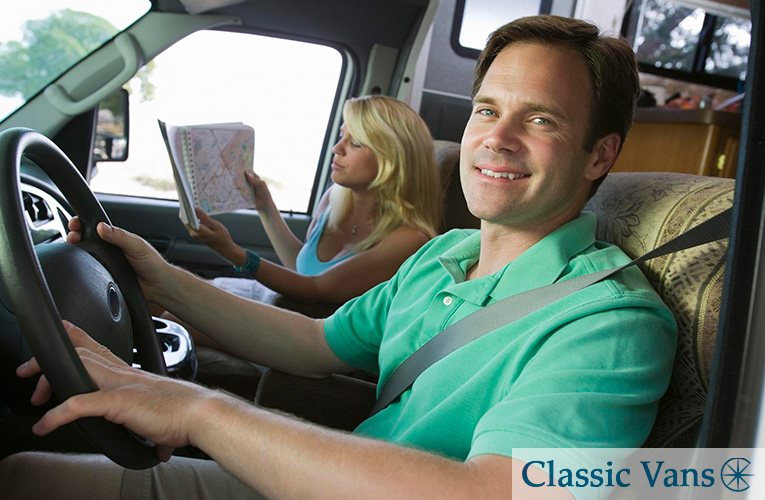
Tips and tricks for driving a campervan for the first-time
Traveling in a class B camper van, motorhome, or recreational vehicle (RV) for the first time is an exciting journey. Regardless of age, most van travelers share an eagerness to explore the country and a aptitude for finding the next great adventure just around the next bend in the road.
One of the most common concerns we get asked about from people who are considering buying, renting, or living out of a camper van is whether or not they can drive it safely. Fortunately, campervans and class B motorhomes are more compact than class A RVs and large motor coaches, making them much easier to drive and maneuver. In fact, many people describe the experience as similar to driving a large van or SUV.
That said, there are some things to keep in mind before driving a motorhome for the first time.
Whether you’re renting a campervan or recently purchased you’re very own motorhome, here are some tips on how to safely drive your travel vehicle.
Proper Licensing
Every state has different laws relating to various modes of transportation. Depending on the length or weight of your vehicle, a special license may be required. Before you make the decision of whether to purchase a new or used camper van, conduct some research to ensure you are legally allowed to drive one. Start by asking the seller or dealer.
If a license is required, this process is relatively painless and takes about the same time as it does to receive a regular driver’s license. Special driving courses are available in select states to ensure this license is obtained.
Lower Speeds
One of the biggest adjustments to owning an campervan is that you may be travelling at lower speeds than you’re accustomed to. You’ve undoubtedly experienced a time when you got stuck behind a much larger, slower vehicle in the fast lane.
Remember this feeling and be sure to be courteous of other drivers on the road when driving your motorhome. Only pass slower moving vehicles if it’s absolutely necessary. The fewer lane changes, the safer your travels will be.
Relax, slow down, and just enjoy the journey.
Vehicle Height
Overpasses that may offer ample clearance for traditional vehicles may pose a risk depending on the height of your campervan or motorhome. Know the exact height of your vehicle and be vigilant of road signs that divulge the clearance height of low bridges.
Wind is another factor to watch out for with a motorhome. High winds can pose a risk to semi-trucks, RVs, and even motorhomes with a high profile. Listen to weather alerts to avoid driving your campervan during gusty conditions.
You can also utilize GPS technology to ensure you remain on as many interstates and highways as possible as to avoid low bridges and other obstacles. The safety of yourself and your family is of utmost importance, so the extra caution is well worth the time.
Vehicle Weight
A typical camper van or motorhome weighs quite a bit more than a traditional family car. This will affect the way it’s driven. First, be cautious about parking your van on soft ground at a campsite or driving off-road for risk of sinking into mud and becoming stuck.
Also, loaded-down campervans typically require a longer distance to slow down and come to a complete stop. This means that you should always allow for a larger distance between you and cars in front of you while driving, as well as start braking well in advance of a stop or speed limit reduction.
Vehicle Length
The length of a standard camper van or motorhome require a few additional adjustments to be made when driving. First, your turns will have to be taken wider than in a smaller car. Also, you’ll now need to leave more space for things like merging and switching lanes on the highway. The best way to handle this is to be patient and not to take any driving risks.
Your van’s length should also be noted when finding a parking spot at a campground or at a store to pick up supplies. It’s best to park away from other vehicles to avoid possible damages.
Fuel Type
Most class B motorhomes utilize diesel fuel as opposed to regular gasoline. While you may feel this is easy to remember, you’d be surprised just how many people accidentally put regular gasoline in their diesel van without thinking. Putting the wrong type of gas in any vehicle can cause damage to the engine and will likely require the tank to be drained by a mechanic. Consult your vehicle owner’s manual to find out its fuel recommendations.
Manual Transmission
Depending on your motorhome, you may have to know how to drive a manual transmission vehicle. If you’ve never driven stick before, consider learning and practicing on a smaller vehicle and then gradually work your way up to a full sized campervan.
Fortunately, once you get it down pat, many drivers claim it’s just like riding a bike — once you learn how to do it, you never forget.
Proper Storage
Because of the sheer size of motorhomes, there are many additional features and storage space not usually available in traditional vehicles. This can include overhead storage, exterior storage, and awnings. It’s important to make sure that everything is stowed away properly and securely fastened before you get back on the road.
Driving a class B motorhome or campervan isn’t very difficult. The main factors to remember are that your vehicle is larger than others on the road and patience is a must. We recommend driving your motorhome to an empty parking lot and practicing how to drive it. Get comfortable with the feeling of being behind the wheel.
As you become a more experienced camper van driver, you will have the ability to access more exotic and off-the-beaten-path destinations. These memories are sure to last a lifetime.